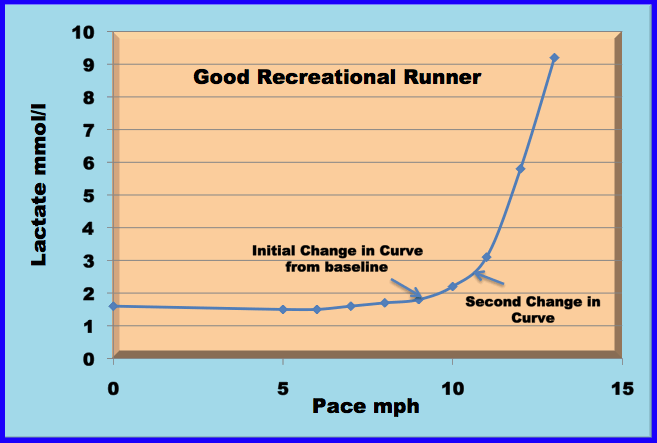Lactate Thresholds - Definitions
or click here to enter website
or click here for Secrets of Lacate Course - available online
If you are looking for a simple definition of the lactate threshold that everybody agrees to, you will not find it here because there isn't one. People use different defintions and that is why it is confusing. We will use the following definition as the lactate threshold on this web site:
The lactate threshold is the maximal effort or intensity that an athlete can maintain for an extended period of time with little or no increase in lactate in the blood. It is an effort or intensity and not a specific lactate level. It is most often described as a speed or pace such as meters per second, or times to achieve certain distances such as minutes per mile or kilometer for running and minutes per 100 m in swimming, or as a power meaure such as watts.
The curve below is a typical lactate curve. Several measurements have been taken as well as a resting lactate. Notice that the lactate remains close to the resting rate for several measurements even though the muscles are producing anaerobic energy, and producing lactate.The lactate is not yet leaving the muscles and most is being consumed for aerobic metabolism in the originating muscles. When the lactate starts to rise, this means some of the lactate being produced is leaving the muscles and entering the bloodstream. It is often hard to pinpoint a specific place on the curve where the rise really starts. We will ask a question of the reader: where does the lactate curve start to rise? The problem with getting an acceptable answer to this question has taken up a lot of the time of many researchers.
Originally this point where the lactate rises was called the "anaerobic threshold" because the rise in lactate was thought to indicate the beginning of anaerobic metabolism. Other researchers then re-named this point where the lactate rises, as the "lactate threshold" and used the term "anaerobic threshold" for a higher point on the curve. In fact there is no real threshold at the point where lactate starts to rise, nor has any real transition taken place; still, several different researchers used the term “threshold” for this point.
As noted above, we prefer to use the maximal lactate steady state as the definition for the lactate threshold as this value has physiological meaning. This is thought to coincide with the second change in the curve but again finding that specific point by some visual or mathematical approach is problematic. Other researchers use the point 1 mmol/l above base line as the lactate threshold because this coincides approximately with the point where marathoners run their races. Someone found more than 20 different definitions of the lactate threshold in the exercise science literature. There is much more written on this on the Threshold page.
